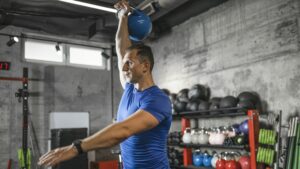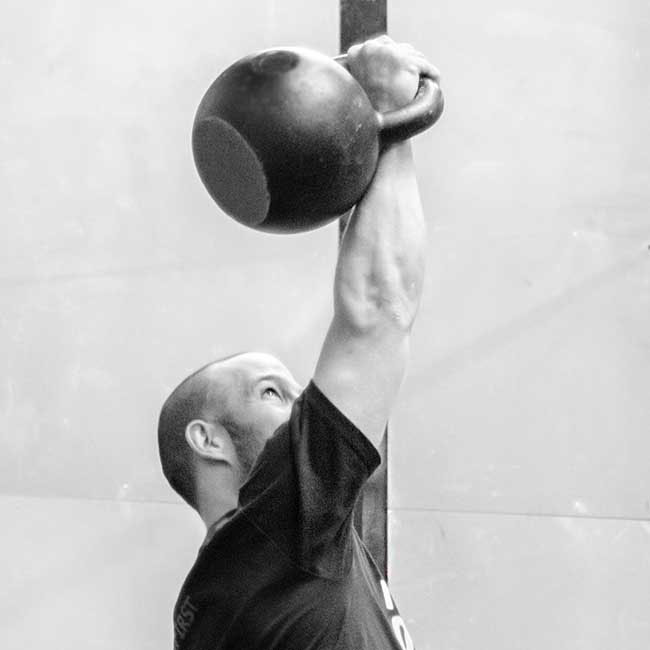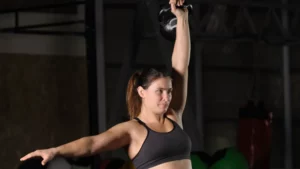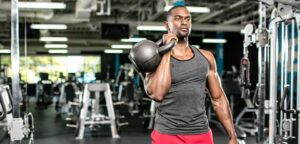KETTLEBELL PRESS : THE COMPLETE GUIDE
How to perform the kettlebell press?
The kettlebell press, or kettlebell military press, is a kettlebell exercise that involves lifting a kettlebell overhead using shoulder, arm and abdominal strength. It is a versatile movement that can be used to develop strength, stability and coordination.
The purpose of this article is to present the basics of the kettlebell press, its different variations, the muscles involved, the training programs for the press, the common mistakes to avoid and tips to progress in the practice of this exercise.
The fundamentals of kettlebell press
The starting posture
The starting posture is essential to the success of the kettlebell press. It consists of standing with your feet shoulder-width apart, your back straight and your abdominals engaged.
The rise of the kettlebell
The ascent is the stage where the kettlebell is lifted above the head. It is important to keep your back straight, your abs tight and your back engaged. The kettlebell should be pushed up using shoulder and arm strength.
Locking the kettlebell in the up position
The kettlebell lock up is the stage where the kettlebell is held overhead with the arm extended and the shoulder stable. This position can be held for a few seconds to build stability and strength.
The descent of the kettlebell
Lowering the kettlebell is the step where the kettlebell is brought back to the starting position. It is important to control the descent of the kettlebell and bring it back to the starting position while keeping your back straight and your abs tight.

The different variants of kettlebell press
The kettlebell press can be performed with one or two hands, and can also be alternated between the two hands. Each variant has specific advantages.
The one-handed kettlebell press
The advantages of the one-handed kettlebell press
The one-handed kettlebell press is a very complete exercise that strengthens balance, coordination and stability. By using one hand to lift the kettlebell, it is possible to develop incredible strength in the shoulder and triceps.
The basics of the one-handed kettlebell press
To begin, hold the kettlebell with one hand and place it on your shoulder. Spread your feet about shoulder width apart for better stability. While keeping your free arm extended at your side for balance, push the kettlebell upward as you exhale and keep your core contracted. Make sure your elbow stays close to your body. The arm should remain in extension above the head, fully extended with the wrist straight. Keep your abs tight to avoid losing your balance.
Mistakes to avoid during the one-handed kettlebell press
For a beginner, it is important to be careful not to lean the body to the side when pressing, as this can cause pressure on the lower back. This can be used to lift heavier weights, but it is reserved for advanced practitioners of this movement. Also make sure to maintain good posture by keeping your abs tight and your wrist straight throughout the exercise. Keep your gaze forward to avoid twisting your neck.
The two-handed kettlebell press
The two-handed kettlebell press is an advanced variation of the press, as it requires good chest mobility. It is ideal for experienced athletes looking to focus on raw strength and muscular endurance.
The benefits of the two-hand kettlebell press
The two-handed kettlebell press is an excellent exercise for building upper body strength and endurance, especially the shoulders, triceps and pecs. It is also effective in strengthening the stabilizing muscles of the back and abdominal muscles.
The fundamentals of the two-handed kettlebell press
- Stand with a kettlebell in each hand, feet shoulder width apart
- Engage your abs and contract your glutes to maintain a strong, stable posture
- Lift the kettlebells over your head by pushing with your shoulders and triceps
- Keep your core tight, your back engaged and your wrist straight throughout the movement
- Hold the position at the top for one second before slowly lowering the kettlebells towards your chest
Mistakes to avoid during the two-handed kettlebell press
When performing the two-handed kettlebell press, avoid the following mistakes:
- Leaning back to lift kettlebells: For a beginner, this can put excessive pressure on the spine and cause injury. This technique can be used to lift heavier weights, but is reserved for experienced practitioners.
- Do not have your arms stretched out in a high position: this can reduce the effectiveness of the exercise
- Letting the kettlebells fall on your chest on the way down: this can cause injury
Alternating kettlebell press
The alternate kettlebell press is a variation of the two-handed press. It is an ideal technique to develop balance and coordination.
Benefits of the Alternate Kettlebell Press
The alternating kettlebell press offers several benefits for the body. It strengthens the muscles of the chest, shoulders, arms and abdominals, while improving balance and coordination. It also works both sides of the body equally, reducing the risk of muscle imbalances and injuries.
The fundamentals of the kettlebell press
- Stand with a kettlebell in each hand, feet shoulder width apart
- In the same way as for the one-handed press, push a kettlebell over your head by extending your arm
- Lower the kettlebell to your chest, then lift the second kettlebell
Mistakes to avoid during the kettlebell press alternation
- Not keeping a good posture: it is important to keep the back straight and the abdominal muscles tight to avoid injury
- Not keeping the kettlebell stable: make sure to keep the kettlebell stable and controlled throughout the movement
- Do not keep the arm close to the body: the arm must be kept close to the body throughout the movement to avoid unnecessary tension in the shoulder

Muscles involved in the kettlebell press
The kettlebell press is a complete strength training exercise that involves several muscle groups. The main muscles involved are the shoulders, triceps and pectoral muscles. The secondary muscles involved are the trapezius, abdominal muscles and gluteal muscles.
The shoulders
The shoulders are the muscles most used during the kettlebell press. More specifically, it is the anterior fascicle of the deltoid muscle, which allows for flexion and elevation of the arm. The pressure exerted on the shoulders during the exercise is very intense, which is why it is important to warm up properly and not to force yourself during the first sessions.
The triceps
The triceps are the posterior muscles of the arm, located between the shoulder and the elbow. They are used during the push, and especially during the locking phase of the kettlebell in the upper position. The triceps are important muscles for arm stability and power.
The pectoral muscles
The pectorals are the muscles located on the chest. Although they are not directly solicited during a vertical press, they intervene indirectly by supporting the shoulders and stabilizing the upper body.
The trapezoids
The trapezius are the muscles located at the base of the neck. They are used during the ascent phase of the kettlebell, as they help stabilize the shoulders and maintain good posture.
The abdominals
Abdominals help to maintain stability of the trunk and spine. It is therefore important to strongly contract the abs during the exercise.
Buttocks
The glutes are involved in the stabilization of the body and in the transmission of force from the bottom to the top of the body. The glutes are also important for posture and back health.

Training programs for the kettlebell press
In order to take full advantage of the kettlebell press and to progress efficiently, it is important to follow a training program adapted to your level and your goals. Here are a few programs to help you practice this movement.
Basic session
If you are new to the kettlebell press, it is recommended that you start with a basic program to familiarize yourself with the movement and strengthen your body. Here is an example of a basic program:
- Warm-up (5-10 minutes): Start with a warm-up to prepare your body for the effort. You can perform joint mobility exercises and light stretching.
- Main workout (20-30 minutes): Devote 20-30 minutes to the one-handed kettlebell press. Perform 3 to 5 sets of each exercise, with 8 to 12 reps per set. Be sure to take enough rest between sets to fully recover.
- Complementary Workout (10-15 minutes): To strengthen your muscles and improve your stability, add complementary exercises such as abdominal, gluteal and trapezius strengthening.
Advanced session
If you are already experienced with the kettlebell press and want to continue to progress, here is an advanced program to help you reach your goals:
- Warm-up (10-15 minutes): Start with a warm-up to prepare your body for the effort. You can perform joint mobility exercises and stretching.
- Main workout (30-45 minutes): Devote 30-45 minutes to the two-handed kettlebell press, then the one-handed kettlebell press. Perform 3 to 5 sets of each exercise, with 5 to 8 reps per set. Be sure to take enough rest between sets to fully recover.
- Complementary Workout (15-20 minutes): To strengthen your muscles and improve your stability, add complementary exercises such as abdominal, gluteal and trapezius strengthening.
8 week program specific to the kettlebell press (one or two hands)
If you want to focus on the kettlebell press, it is important to follow a specific program that will allow you to progress safely and effectively. Here is a sample program to help you train:
Week 1-2: Learning the basics
- 2 to 3 sessions per week
- 3 sets of 8 to 10 repetitions with a light kettlebell
- Rest 60 to 90 seconds between each set
- Focus on posture, grip, climbing and locking the kettlebell in the up position
Week 3-4: Strengthening the muscles involved
- 2 to 3 sessions per week
- 3 to 4 sets of 5 to 8 reps with a medium kettlebell
- Rest 60 to 90 seconds between each set
- Focus on the use of leg and core strength to assist the kettlebell lift
Week 5-6: Progression to heavier loads
- 2 to 3 sessions per week
- 4 sets of 5 to 6 repetitions with a heavy kettlebell
- Rest 2 to 3 minutes between each set
- Focus on the press technique and the control of the kettlebell’s descent
Week 7-8: Consolidation of skills and progression to even heavier loads
- 2 to 3 sessions per week
- 5 sets of 3 to 5 repetitions with a very heavy kettlebell
- Rest 3 to 4 minutes between each set
- Focus on gradually increasing the load while maintaining proper technique
It is important to note that training programs may vary depending on individual goals. Feel free to adjust sets, reps and loads according to your fitness level and specific goals.

Tips for progressing with the kettlebell press
Regularity of training
Consistency of training is important to progress with the kettlebell press. Train regularly and incorporate the press into your overall training program. Try to work out at least twice a week for best results.
The gradual increase of the load
The progressive increase of the load is also important to progress in the press. Start with a light load and gradually increase over time. Adding just a few pounds a month can make a big difference in the long run.
Adapting the training program
It is important to adapt your training program to your fitness level and goals. If you are a beginner, start with simple exercises and work on your technique before moving on to more advanced exercises. If you are more advanced, add more difficult press variations or incorporate it into a more complex training program.
Rest and recovery
Rest and recovery are important to progress. Give yourself enough recovery time between workouts to allow your muscles to repair and strengthen. Sleep and a healthy, balanced diet can also help speed up the recovery process.
Conclusion
The kettlebell press is a versatile exercise that can offer many benefits to your health and fitness. By working the muscles of the shoulders, triceps, pecs, trapezius, abs and glutes, the kettlebell press can help you develop overall strength and power, as well as good muscle mass. With good technique, proper progression and regular training, you will progress quickly.

